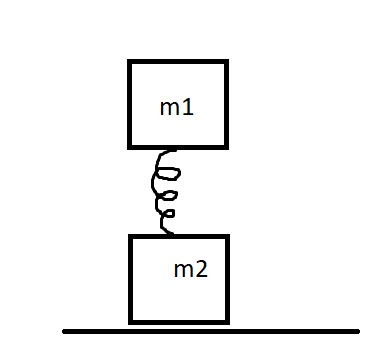
The system when placed on a table as shown oscillates with frequency \[{f_1}\] . If the table is withdrawn, the system oscillates with a frequency \[{f_2}\] . The ratio \[\dfrac{{{f_1}^2}}{{{f_2}^2}}\] will be:

(A) \[\dfrac{{{m_1} + {m_2}}}{{{m_1}}}\]
(B) \[\dfrac{{{m_2}}}{{{m_1} + {m_2}}}\]
(C) \[\dfrac{{{m_1}}}{{{m_1} + {m_2}}}\]
(D) None
Answer
214.2k+ views
Hint: Find the time period of oscillation of the system. Using time period, find the relation between time period and frequency for both objects individually. Divide the squares of frequency and find out the solution.
Complete step by step solution:
The figure given consists of 2 masses attached to a given spring of spring constant k and length x. When the table is withdrawn from the second mass, the system begins to have increased oscillations of frequency \[{f_2}\] . Now we can first find the time period required for the oscillations to occur.
This is mathematically expressed as ,
\[T = 2\pi \times \sqrt {\dfrac{m}{k}} \]
Wherein T is the time period of oscillations, m is the mass of the object and K is the spring constant of the spring.
Now we know that frequency of an oscillation is inversely proportional to the time period of oscillations.
\[f = 1/T\]
\[ \Rightarrow f = 1/(2\pi \times \sqrt {\dfrac{m}{k}} )\]
\[ \Rightarrow f = \dfrac{1}{{2\pi }} \times \sqrt {\dfrac{k}{m}} \]
For Object 1,
\[ \Rightarrow {f_1} = \dfrac{1}{{2\pi }} \times \sqrt {\dfrac{k}{{{m_1}}}} \]
For Object 2,
\[ \Rightarrow {f_2} = \dfrac{1}{{2\pi }} \times \sqrt {\dfrac{k}{{{m_2} + m1}}} \]
Note: Since the table is removed, the frequency experienced by the downgoing object will also experience the mass of the first object .
Now \[\dfrac{{{f_1}^2}}{{{f_2}^2}}\] will be
\[ \Rightarrow \dfrac{{{f_1}}}{{{f_2}}} = \dfrac{{\dfrac{1}{{2\pi }} \times \sqrt {\dfrac{k}{{{m_1}}}} }}{{\dfrac{1}{{2\pi }} \times \sqrt {\dfrac{k}{{{m_2} + m1}}} }}\]
Cancelling the like terms,
\[ \Rightarrow \dfrac{{{f_1}}}{{{f_2}}} = \dfrac{{\sqrt {\dfrac{k}{{{m_1}}}} }}{{\sqrt {\dfrac{k}{{{m_2} + m1}}} }}\]
Squaring on both sides we obtain,
\[ \Rightarrow \dfrac{{{f_1}^2}}{{{f_2}^2}} = \dfrac{{\dfrac{k}{{{m_1}}}}}{{\dfrac{k}{{{m_2} + m1}}}}\]
Removing spring constant k from the above equation,
\[ \Rightarrow \dfrac{{{f_1}^2}}{{{f_2}^2}} = \dfrac{{\dfrac{1}{{{m_1}}}}}{{\dfrac{1}{{{m_2} + m1}}}}\]
\[ \Rightarrow \dfrac{{{f_1}^2}}{{{f_2}^2}} = \dfrac{{{m_2} + m1}}{{{m_1}}}\]
Therefore, Option (A) is the correct answer to the following question.
Note:
The time period is defined as a time period required by a body expressing periodic motion to complete one period or one cycle. Frequency is defined as the repetition of the event per unit time. Frequency is measured in Hertz whereas the time period is measured in seconds. Frequency is inversely proportional to time period of the oscillation.
Complete step by step solution:
The figure given consists of 2 masses attached to a given spring of spring constant k and length x. When the table is withdrawn from the second mass, the system begins to have increased oscillations of frequency \[{f_2}\] . Now we can first find the time period required for the oscillations to occur.
This is mathematically expressed as ,
\[T = 2\pi \times \sqrt {\dfrac{m}{k}} \]
Wherein T is the time period of oscillations, m is the mass of the object and K is the spring constant of the spring.
Now we know that frequency of an oscillation is inversely proportional to the time period of oscillations.
\[f = 1/T\]
\[ \Rightarrow f = 1/(2\pi \times \sqrt {\dfrac{m}{k}} )\]
\[ \Rightarrow f = \dfrac{1}{{2\pi }} \times \sqrt {\dfrac{k}{m}} \]
For Object 1,
\[ \Rightarrow {f_1} = \dfrac{1}{{2\pi }} \times \sqrt {\dfrac{k}{{{m_1}}}} \]
For Object 2,
\[ \Rightarrow {f_2} = \dfrac{1}{{2\pi }} \times \sqrt {\dfrac{k}{{{m_2} + m1}}} \]
Note: Since the table is removed, the frequency experienced by the downgoing object will also experience the mass of the first object .
Now \[\dfrac{{{f_1}^2}}{{{f_2}^2}}\] will be
\[ \Rightarrow \dfrac{{{f_1}}}{{{f_2}}} = \dfrac{{\dfrac{1}{{2\pi }} \times \sqrt {\dfrac{k}{{{m_1}}}} }}{{\dfrac{1}{{2\pi }} \times \sqrt {\dfrac{k}{{{m_2} + m1}}} }}\]
Cancelling the like terms,
\[ \Rightarrow \dfrac{{{f_1}}}{{{f_2}}} = \dfrac{{\sqrt {\dfrac{k}{{{m_1}}}} }}{{\sqrt {\dfrac{k}{{{m_2} + m1}}} }}\]
Squaring on both sides we obtain,
\[ \Rightarrow \dfrac{{{f_1}^2}}{{{f_2}^2}} = \dfrac{{\dfrac{k}{{{m_1}}}}}{{\dfrac{k}{{{m_2} + m1}}}}\]
Removing spring constant k from the above equation,
\[ \Rightarrow \dfrac{{{f_1}^2}}{{{f_2}^2}} = \dfrac{{\dfrac{1}{{{m_1}}}}}{{\dfrac{1}{{{m_2} + m1}}}}\]
\[ \Rightarrow \dfrac{{{f_1}^2}}{{{f_2}^2}} = \dfrac{{{m_2} + m1}}{{{m_1}}}\]
Therefore, Option (A) is the correct answer to the following question.
Note:
The time period is defined as a time period required by a body expressing periodic motion to complete one period or one cycle. Frequency is defined as the repetition of the event per unit time. Frequency is measured in Hertz whereas the time period is measured in seconds. Frequency is inversely proportional to time period of the oscillation.
Recently Updated Pages
Chemical Equation - Important Concepts and Tips for JEE

JEE Main 2022 (July 29th Shift 1) Chemistry Question Paper with Answer Key

Conduction, Transfer of Energy Important Concepts and Tips for JEE

JEE Analytical Method of Vector Addition Important Concepts and Tips

Atomic Size - Important Concepts and Tips for JEE

JEE Main 2022 (June 29th Shift 1) Maths Question Paper with Answer Key

Trending doubts
JEE Main 2026: Application Form Open, Exam Dates, Syllabus, Eligibility & Question Papers

JEE Main Correction Window 2026 Session 1 Dates Announced - Edit Form Details, Dates and Link

Equation of Trajectory in Projectile Motion: Derivation & Proof

JEE Main 2026 Application Login: Direct Link, Registration, Form Fill, and Steps

Hybridisation in Chemistry – Concept, Types & Applications

Angle of Deviation in a Prism – Formula, Diagram & Applications

Other Pages
JEE Advanced Marks vs Ranks 2025: Understanding Category-wise Qualifying Marks and Previous Year Cut-offs

Units And Measurements Class 11 Physics Chapter 1 CBSE Notes - 2025-26

NCERT Solutions For Class 11 Physics Chapter 8 Mechanical Properties Of Solids

Motion in a Straight Line Class 11 Physics Chapter 2 CBSE Notes - 2025-26

NCERT Solutions for Class 11 Physics Chapter 7 Gravitation 2025-26

Collision: Meaning, Types & Examples in Physics




